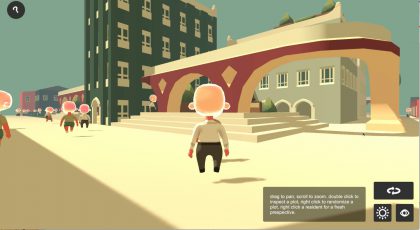
The Scholastic Awards were excited to present a new award this year: The ESA Foundation Award for Video Game Design. Underwritten by the ESA Foundation, this award recognizes two outstanding video game designs with $1,000 scholarships.
Congratulations to the 2019 recipients!
Ashley Barg, Brenna Brown, Mary Grace Garcia, Van Nguyen, Melissa Ran, and Ella Wilson
Learn more about DEADication:
“In DEADication, you play the character of a zombie who saunters about the room looking for clues. The zombie is aided by a bunny creature that speaks and exposits information that helps you solve the puzzle. The zombie is controlled by the arrow keys on your keyboard and you gain the pieces of the puzzle by clicking on the exclamation marks with your mouse. After you have completed every level, the zombie flees the hospital via the zombie rights activist helicopter. . . . DEADication is a fun, entertaining game about a zombie escaping a hospital.”

Learn more about Metroprovement:
“Metroprovement is a simulation game in which the player improves quality of life for the residents of a procedurally generated city. The player can remove roads, generate new kinds of buildings and parks, explore different modes of transportation, and watch smog clear up, encouraging more people to come out of their homes to roam the streets. Each town is dynamically generated, from the windows on each individual building to the large-scale structure and streets! Three colorful times of day to play in. Re-generate a plot with a click. See your creation from the eyes of each little resident. In the menu, there are a few meters to keep an eye on. One is the ratio of space used by humans, space used by nature, and space consumed by asphalt (motor ways and parking lots), the goal is to maximize human and nature usage, minimize asphalt coverage. In order to achieve this objective, players are encouraged to experiment with a new form of transportation, such as the monorail, which consumes only 5% of eco-footprint as cars and is naturally segregated from pedestrian traffic. The others are metrics of your city’s progress: one measures the residents’ social wellness, another measures the environmental-friendliness of the place, and lastly, one bar for the general quality of life there. Social wellbeing is measured by the amount of “human” space (parks, walkways, etc.) and how easy neighbors can mingle together. For example, convert a motorway into a pedestrian street by elevating transport from ground to monorail, to make sweet into a linear park, for biking, running, children’s playground, and even dancing, curbside restraints to improve wellbeing. Eco-friendliness is calculated by the area of space devoted to nature, the number of trees, etc. and detracted from by roads, parking lots, and wasted space such as suburban lawns.”
